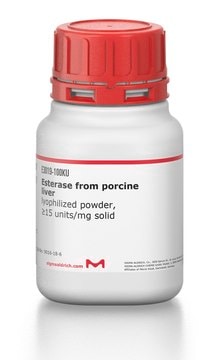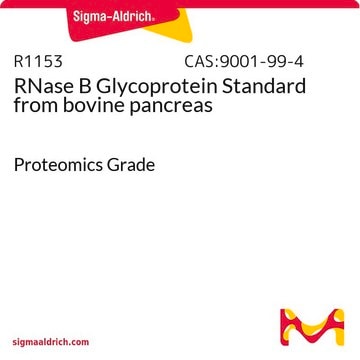The form of fetuin has not been determined. This material has not been sequenced. The minimum allowable sialic acid content is 0.5%. The molecular weight is approximately 44,200 daltons. The starting material for this product has a molecular weight of approximately 48,400 including an estimated 8.7% sialic acid. According to the UniPro values for each, the Fetuin-B molecular weight is calculated at 42,663 while the Fetuin-A is 38,419.
A4781
Asialofetuin aus Kälberserum fötal
Type I (Sigma designation)
Synonym(e):
Asialofetuin
Größe auswählen
Größe auswählen
About This Item
Empfohlene Produkte
Biologische Quelle
bovine (calf) serum
Qualitätsniveau
Typ
Type I (Sigma designation)
Form
powder
Verunreinigungen
salt, essentially free
≤0.5% N-acetylneuraminic acid
Löslichkeit
0.85% sodium chloride: soluble 1 mg/mL
Lagertemp.
2-8°C
Suchen Sie nach ähnlichen Produkten? Aufrufen Leitfaden zum Produktvergleich
Allgemeine Beschreibung
Anwendung
- Zur Quantifizierung der pflanzlichen Rizin-Toxin-B-Untereinheit(RTB)-Lektinaktivität in β-Phaseolin-Signalpeptid(P)-Proinsulin-Gen(INS)-RTB-Pflanzen mittels Enzyme-linked immunosorbent assay (ELISA)[2]
- Zur Quantifizierung des VP7:RTB-Fusionsproteins in transformiertem Kartoffelgewebe mittels ELISA[3]
- Als Glykoproteinsubstrat zum Messen der Rezeptorbindungsaktivität von rekombinanten RTB- und NSP490-RTB-Fusionsproteinen[4]
- Zur Untersuchung der Art der Wechselwirkung zwischen Ferritin und der Plazenta[5]
Biochem./physiol. Wirkung
Angaben zur Herstellung
Lagerklassenschlüssel
11 - Combustible Solids
WGK
WGK 3
Flammpunkt (°F)
Not applicable
Flammpunkt (°C)
Not applicable
Persönliche Schutzausrüstung
Eyeshields, Gloves, type N95 (US)
Hier finden Sie alle aktuellen Versionen:
Analysenzertifikate (COA)
Die passende Version wird nicht angezeigt?
Wenn Sie eine bestimmte Version benötigen, können Sie anhand der Lot- oder Chargennummer nach einem spezifischen Zertifikat suchen.
Besitzen Sie dieses Produkt bereits?
In der Dokumentenbibliothek finden Sie die Dokumentation zu den Produkten, die Sie kürzlich erworben haben.
Kunden haben sich ebenfalls angesehen
-
To wich fetuin corresponds your product A4781 (Asialofetuin from fetal calf serum). Is it Protein Fetuin-A ? Uniprot entry: P12763 FETUA_BOVIN or protein Fetuin-B ? Uniprot entry: Q58D62 FETUB_BOVIN Do you have de amino acid sequence?
1 answer-
Helpful?
-
-
Hi, What is the difference in Type 1 versus Type II asialofetuin
1 answer-
The difference between the Type I and Type II Asialofetuin products does not represent any kind of biochemical or functional difference. These indicate different methods of production and purification. The Type II option, product A1908, utilizes neuraminadase in an enzymatic cleavage step. The Type I, product A4781, uses a proprietary modification of that described in Spiro, R.G., J. Biol. Chem., 235, 2860 (1960).
Helpful?
-
Active Filters
Unser Team von Wissenschaftlern verfügt über Erfahrung in allen Forschungsbereichen einschließlich Life Science, Materialwissenschaften, chemischer Synthese, Chromatographie, Analytik und vielen mehr..
Setzen Sie sich mit dem technischen Dienst in Verbindung.
















